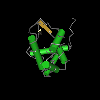?
 
ARID/BRIGHT DNA binding domain of Jumonji/ARID domain-containing protein 2 (JARID2) and similar proteins JARID2, also called protein Jumonji, is a DNA-binding protein that contains both the Jumonji C (JmjC) domain and AT-rich DNA-interacting domain (ARID, also known as BRIGHT). It is an interacting component of Polycomb repressive complex-2 (PRC2) that catalyzes methylation of lysine 27 of histone H3 (H3K27) and regulates important gene expression patterns during development. It exhibits nucleosome-binding activity that contributes to PRC2 stimulation. However, unlike other JmjC domain-containing proteins, JARID2 is catalytically inactive due to the lack of conserved residues essential for histone demethylase activity. JARID2 is also involved in transforming growth factor-beta (TGF-beta)-induced epithelial-mesenchymal transition (EMT) of lung and colon cancer cell lines through the modulation of histone H3K27 methylation. Moreover, JARID2 is a part of GLP- and G9a-containing protein complex that promotes lysine 9 on histone H3 (H3K9) methylation on the cyclin D1 promoter and silences the expression of cyclin D1 and other cell cycle genes. It functions as a transcriptional repressor that plays critical roles in embryonic development including heart development in mice, and regulates cardiomyocyte proliferation via interaction with retinoblastoma protein (Rb), one of the master regulatory genes of the cell cycle. Furthermore, JARID2 acts as a transcriptional repressor of target genes, including Notch1. It directly binds to SETDB1 (SET domain, bifurcated 1) to form a complex that plays an important role in a novel process involving the modification of H3K9 methylation during heart development. Meanwhile, JARID2 is a key transcriptional repressor that plays a role in invariant natural killer T (iNKT) cell maturation. It regulates promyelocytic leukemia zinc finger (PLZF) expression by linking T-cell receptor (TCR) signaling to H3K9me3. JARID2 polymorphisms are associated with non-syndromic orofacial clefts (NSOC) susceptibility. |
